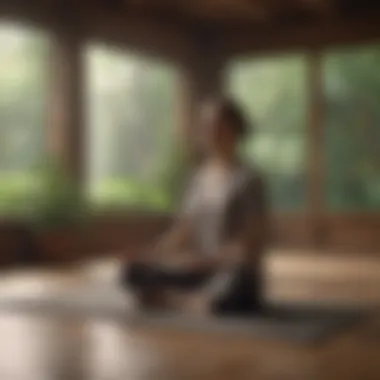Mastering Quick Meditation Techniques for Busy Lives


Intro
In today’s fast-paced world, the need for effective mental wellness practices is more pressing than ever. Many individuals face relentless demands from their personal and professional life, leaving little room for self-care and reflection. This article addresses the pressing need for rapid meditation techniques. It provides a comprehensive guide to achieving mental clarity and well-being in short bursts, suitable for anyone, especially those with limited time.
Understanding Mental Health and Well-being
What is Mental Health?
Mental health encompasses emotional, psychological, and social well-being. It influences how individuals think, feel, and act. Mental health is also critical for decision-making, stress management, and interpersonal relationships.
The Importance of Prioritizing Mental Well-being
Prioritizing mental health is crucial. It helps individuals navigate challenges, achieve personal goals, and maintain relationships. When mental well-being is neglected, the risk of developing various disorders increases significantly. Investing time in mental health is as vital as physical health.
Common Mental Health Challenges and Disorders
Common mental health challenges may include anxiety, depression, and stress-related disorders. These conditions can manifest differently across individuals. Recognizing these challenges is the first step towards finding effective strategies for relief.
To incorporate effective meditation into a busy schedule, several strategies can be adopted.
Mindfulness Techniques
Mindfulness involves focusing on the present moment without judgment. Practicing mindfulness can be as simple as paying attention to your breath or to the sensations in your body. This practice helps to calm the mind and promote clarity. A short meditation of just five minutes can make a significant impact.
Breathwork
Breathwork is a foundational element in meditation. It enhances focus and relaxation. Simple techniques such as diaphragmatic breathing or the 4-7-8 method can be utilized effectively in short intervals.
Creating A Meditation Schedule
Dedicate specific times for meditation each day. This could be early in the morning or during lunch breaks. Keeping a consistent routine aids in building the habit.
"Consistency is key when establishing a meditation practice. Small, frequent sessions can lead to greater long-term benefits."
Enhancing Personal Development
Goal Setting and Productivity Tips
Set achievable goals regarding meditation practices. Start with shorter durations and gradually increase as comfort develops. This approach prevents feelings of overwhelm.
Practicing Gratitude
Incorporating gratitude into meditation has shown benefits for mental well-being. Spend a few minutes reflecting on positive aspects of life. This shift in focus can diminish feelings of stress and enhance emotional resilience.
Tips for Maintaining Mental Well-being
Strategies for Preventing Burnout
To prevent burnout, consider integrating regular, brief meditation sessions. Small breaks can rejuvenate the mind, boosting productivity.
Creating a Supportive Environment
Establish a dedicated meditation space, free from distractions. This can enhance focus and create a conducive atmosphere for rapid meditation sessions.
Coping with Challenges and Setbacks


Recognize that meditation practice can evolve with time. If challenges arise, evaluate techniques and make necessary adjustments. Engaging in community discussions can provide support and new insights.
End
Understanding Meditation
Meditation serves as a fundamental practice for those aiming to achieve mental clarity and emotional stability. Understanding meditation is crucial in this article as it provides the essential framework upon which rapid meditation techniques can be built. By delving into the concept of meditation, individuals can grasp not only its definition but also the nuances that make it a versatile tool for mental health and well-being.
Defining Meditation
Meditation is often perceived simply as a method of relaxation. However, its true definition encompasses much more. It can be described as a technique that encourages an enhanced state of awareness and focused attention. This focused awareness can lead to a greater understanding of oneself, allowing practitioners to observe thoughts and feelings without immediate reaction. Traditional forms of meditation include practices like Vipassana and Zen, while modern adaptations might blend mindfulness with other techniques. The essence of meditation is to cultivate a state of mindfulness, which paves the way for efficiency in a rapid practice.
The Importance of Mindfulness
Mindfulness is at the core of most meditation practices. It refers to the conscious awareness of the present moment, free of judgment. This is particularly important when integrating rapid meditation into a busy schedule. When individuals practice mindfulness, they develop the ability to remain grounded, reducing anxiety and improving their emotional responses to everyday challenges. Mindfulness not only enhances the meditation experience but also seeps into daily life, leading to improved focus and better relationship interactions. Thus, understanding mindfulness is vital for anyone looking to meditate rapidly and effectively.
Benefits of Quick Meditation
The concept of quick meditation might seem counterintuitive, given the traditional view of meditation as a lengthy process. However, engaging in short, focused meditation sessions can yield substantial benefits. Here are some potential advantages:
- Time Efficiency: Short sessions fit easily into tight schedules, making meditation accessible.
- Reduced Stress Levels: Brief moments of meditation can lower stress, promoting mental clarity.
- Enhanced Focus: Quick meditation helps sharpen concentration and focus, especially useful in today’s fast-paced environment.
- Improved Mood: Even a few minutes of meditation can elevate mood and decrease feelings of anxiety.
"Mindfulness is a way of befriending ourselves and our experience."
In the following sections, we will explore preparatory steps and techniques for implementing rapid meditation into your routine.
Preparation for Fast Meditation
Preparing for rapid meditation is crucial for ensuring an effective and meaningful practice, even within a limited timeframe. The environment and mindset you create can significantly influence your meditation experience. This preparation phase sets the foundation for not just meditating quickly, but also for gaining substantial benefits in mental clarity, emotional balance, and overall well-being.
Creating a Conducive Environment
A conducive environment fosters a sense of calm and focus. This is essential, especially when engaging in fast meditation. Here are several elements to consider:
- Minimizing Noise: Choose a quiet space, if possible. If silence is hard to find, use earplugs or calming soundtracks.
- Comfortable Seating: Use a chair, cushion, or mat that supports your posture. Your comfort is essential for maintaining concentration.
- Lighting: Dim lighting can create a serene atmosphere. If necessary, use natural light or soft lamps to reduce harsh illumination.
By adjusting these aspects of your environment, you help your mind transition into a meditative state more quickly.
Setting Intentions
Setting intentions before meditation can significantly impact your focus and effectiveness during the process. This practice encourages clarity about what you wish to achieve. Here are steps to guide your intention-setting:
- Identify Your Goals: Determine what you hope to gain from your meditation, whether it’s stress relief, mental clarity, or emotional regulation.
- Be Specific: Instead of general goals, formulate precise intentions, such as "I want to feel calm and centered" or "I wish to clarify my thoughts on a specific issue."
- Visualize Your Intention: As you prepare, visualize your intention as achieved. This mental rehearsal can enhance your focus during meditation.
Having clear intentions enables you to direct your thoughts effectively during short meditation sessions. You might find it helpful to write your intentions down, reminding yourself of them as you meditate.
"Preparation lays the groundwork for a fruitful meditation experience, especially when time is of the essence."
In summary, the preparation phase for fast meditation is just as significant as the practice itself. By fostering an appropriate environment and clearly defining your intentions, you enhance not only the speed but also the depth of your meditation, making it a worthwhile element in the journey toward improved mental health and wellness.
Techniques for Rapid Meditation
Techniques for rapid meditation are vital in making the practice accessible for people with demanding schedules. These methods enable individuals to harness the benefits of meditation without lengthy sessions. The importance of mastering these techniques should not be underestimated, as they create opportunities for mindfulness, reduce stress, and promote mental health, even in short bursts. Implementing effective techniques can transform fragmented moments into meaningful meditation experiences.
Breath Awareness


Breath awareness is one of the simplest and most effective techniques for quick meditation. This practice centers on the natural rhythm of breathing, which serves as a grounding tool. Individuals can utilize breath awareness anywhere, making it ideal for fast-paced environments. To begin, find a comfortable position. Focus on inhaling deeply through the nose and exhaling fully through the mouth. Engage with the sensation of air entering and leaving the body.
The benefits are notable. Breath awareness can reduce anxiety and enhance concentration. It invites the mind to settle, moving away from distractions in the environment. While this technique is straightforward, it contains depth. By focusing solely on breath, practitioners are encouraged to observe their thoughts without judgment. This practice cultivates a sense of clarity, which supports mental well-being.
Body Scan Method
The body scan method involves systematically noticing sensations throughout the body. This technique can be practiced quickly within a few minutes. To perform a body scan, find a quiet place and sit or lie down in a comfortable position. Begin by directing attention to your toes, consciously relaxing each body part as you move upwards. Take a moment to observe areas of tension and allow them to soften with each breath.
This method serves as both a relaxation tool and a means to connect with the body. It heightens awareness of physical sensations and encourages practitioners to release stress. The body scan is particularly beneficial for individuals who may find it challenging to clear their minds or choose to anchor their meditation in physical experience. This technique not only aids in mental clarity but also improves overall body awareness.
Visual Focus Technique
The visual focus technique uses sight to assist the meditation practice. This method is particularly effective for those who respond well to visual stimulation. To begin, select a simple object within your environment, such as a candle, plant, or even a piece of artwork. Sit comfortably and allow your gaze to rest on that object. As you observe it, notice its colors, shapes, and textures in detail.
While engaged in this practice, maintain awareness of thoughts that arise. Gently redirect your focus back to the object whenever distractions occur. This technique can foster a greater sense of presence and is often helpful for those who are new to meditation. By cultivating focus visually, individuals can experience a shift in mental clarity, making it easier to transition into mindfulness throughout the day.
"Meditation is not about stopping thoughts, but recognizing that we have thoughts and letting them go."
By incorporating these techniques into daily routines, individuals can effectively utilize short moments for meditation. This approach not only promotes mental health but also makes the practice more approachable for those who are busy.
Incorporating Meditation into Daily Life
Incorporating meditation into daily life is crucial for those seeking a balanced and mindful existence. In our fast-paced world, it can be daunting to find time for traditional meditation practices. This section will emphasize the significance of making meditation a routine, even if it is for a few moments at a time. The aim is to show how quick meditation can fit seamlessly into one’s day-to-day activities without causing added stress.
Short Intervals Throughout the Day
Utilizing short intervals for meditation is an effective approach, especially for individuals with busy schedules. These brief moments offer opportunities to reset your mind and recharge.
- Five-Minute Breaths: Take a five-minute break at work or home. Focus solely on your breath and allow thoughts to come and go without judgment. This can serve as a mental reset like hitting a refresh button on your brain.
- Waiting Moments: Use time spent waiting—whether at a bus stop, in a queue, or before meetings—to practice mindfulness. Close your eyes and focus on your surroundings and your breathing. Doing so helps in grounding yourself and can lead to a more peaceful state of being.
- Post-Activity Reflection: After finishing tasks, take one minute to reflect on what you just completed. Acknowledge your efforts and breathe deeply. This can help create a more profound sense of accomplishment.
By integrating these simple practices, one can cultivate a consistent meditation routine without requiring extended periods of time.
Mindful Pause Practices
Mindful pause practices involve briefly stepping back from activities to reconnect with your inner self. This method brings awareness to the present, aiding in stress reduction and enhancing focus.
- Scheduled Pauses: Block times in your schedule specifically for mindful pauses. Even two to three minutes can make a significant difference. During this time, close your eyes and take deep, deliberate breaths. Notice how your body feels and allow any tension to drop away.
- Incorporation with Daily Routines: These pauses can be integrated into existing routines, such as during coffee breaks, bathroom breaks, or when transitioning between tasks. Each transition serves as a natural cue for a mindful pause.
- Mindful Eating: Transform your meals into moments of meditation. Rather than rushing through, take time to savor each bite. Focus on the flavors, textures, and aroma of your food. This approach turns a typical activity into a meditative experience, promoting gratitude.
In essence, getting creative with how and when you integrate meditation into your life can have profound impacts on mental wellness. Adopting quick, intentional moments of mindfulness can yield lasting benefits.
"Incorporating small moments of meditation can lead to significant changes in how we experience our day-to-day life."
By applying these strategies, individuals can create a lifestyle that values meditation, thereby enhancing their overall quality of life.
Addressing Challenges in Quick Meditation
Incorporating rapid meditation practices into daily life presents a unique set of challenges. Understanding these challenges is crucial for developing effective strategies that enhance the meditation experience. People often struggle with distractions and mental resistance, which can derail the benefits of a quick meditation session. Being aware of these common obstacles can help individuals build resilience and create a more effective meditation practice, even with limited time.
Dealing with Distractions
Distractions are one of the main barriers to effective meditation. In today's fast-paced world, it is common for individuals to be bombarded by noise, notifications, and the demands of daily life. Identifying potential distractions is the first step toward mitigating their impact.
- Environment: Select a quiet space where interruptions are minimized. If you cannot find a completely silent space, consider using headphones to listen to calming music or nature sounds.
- Digital Distractions: Silence your phone or use 'Do Not Disturb' mode during meditation. Notifications can easily break concentration and lead to frustration.
- Mind Wandering: Acknowledge thoughts as they arise without judgment, and gently return your focus to the meditation technique. Gradually, the ability to stay focused will improve.
A consistent practice, even in short bursts, can lead to better control over distractions. Focus not only on finding the right environment but also on preparing your mind to engage in meditation despite external influences.


Overcoming Mental Resistance
Mental resistance often hinders the motivation to meditate. Many individuals find themselves questioning the effectiveness of quick meditation or feeling guilty about taking time for themselves.
- Acknowledge Resistance: Acknowledge these feelings without judgment. Recognize that they are common and do not indicate failure. The mere act of being aware of this resistance is a step towards overcoming it.
- Set Realistic Expectations: Understand that benefits may take time to manifest. Quick meditation can be effective, but its outcomes might not be as immediate as a longer session. Accept that every minute spent in meditation is valuable.
- Start Small: For those new to meditation, starting with just a minute or two can ease anxiety about the practice. Gradually increasing the time allows for acclimatization.
"The greatest journey begins with a single step. Each moment of mindfulness counts."
Ultimately, overcoming mental resistance requires perseverance and patience. Recognize that building a meditation practice is a process, and every effort reinforces your commitment to mental wellness.
Evaluating Your Practice
Evaluating your meditation practice is a critical step in developing and maintaining a fruitful routine. It allows individuals to assess how well their current strategies serve their needs. Without this evaluation, progress may be stalled or even overlooked. Regular reflection not only highlights what works but also identifies areas requiring adjustment. With busy lives, it can be easy to forget why meditation was started in the first place. Hence, evaluation keeps focus sharp and intentions clear.
By consistently reviewing what you have engaged with, you ensure that meditation is not merely routine but a meaningful practice that evolves with your lifestyle. Key elements to consider include the duration of your sessions, the techniques employed, and any shifts in your mental clarity or emotional stability. Understanding these aspects leads to improved effectiveness in your practice.
"The practice of meditation is not just about sitting down and breathing; it’s about understanding what happens in that time frame.”
Reflection on Progress
Reflection on your progress in meditation is vital for genuine growth. It is about more than noting whether you feel relaxed after practice; it involves a deeper inquiry into how meditation has influenced your daily life. Keeping a journal can be helpful in documenting feelings and thoughts associated with each session. This could help pinpoint any recurring issues or patterns.
Consider reflecting on:
- Changes in your emotional state before and after meditation.
- Any distractions faced during practice and your responses to them.
- Enhanced awareness of your thoughts and feelings.
These reflections can offer insight into your journey, making the practice feel more personal and tailored to your unique experiences. Moreover, recognizing progress, irrespective of how small, builds motivation and commitment.
Adjusting Techniques as Needed
As with any practice, flexibility is essential in meditation. Not every technique will resonate with every individual. Over time, shifts in personal preferences, lifestyles, or emotional states may necessitate changes to your meditative techniques. It could be helpful to experiment with different approaches or intensities based on what you discover through reflection.
For example:
- If breath awareness feels stale, integrating short visual focus techniques could revitalize your practice.
- Trying varying durations of sessions can also influence results; a five-minute meditation might be beneficial on particularly busy days.
The goal is to cultivate a practice that aligns closely with your current state and needs. Continuous evaluation and adjustment will ultimately foster growth and a deeper connection to meditation.
Being mindful of disruptions and suitable responses not only strengthens your practice but guards against burnout, ensuring that meditation remains a source of calm and clarity.
Additional Resources for Fast Meditation
In today's fast-paced world, finding time to meditate can be a significant challenge. This is where additional resources come in. They can provide guidance, support, and structures that simplify the process of integrating meditation into a busy lifestyle. Using various tools and readings can enhance understanding and effectiveness of rapid meditation practices. These resources help in personalizing the meditation journey, allowing one to tailor the experience to fit individual needs and schedules. Moreover, they can introduce new techniques and practices that might resonate better with one’s personal style or current state of mind.
Recommended Readings
Literature on meditation offers a wealth of knowledge and strategies that can greatly assist in developing effective habits. Consider reading authors like Jon Kabat-Zinn, who emphasizes mindfulness in daily activities, which can be incredibly relevant for those looking to meditate quickly. Other recommended books include:
- The Miracle of Mindfulness by Thich Nhat Hanh
- Wherever You Go, There You Are by Jon Kabat-Zinn
- The Headspace Guide to Meditation and Mindfulness by Andy Puddicombe
These texts provide practical exercises and insight into how to meditate efficiently. Furthermore, they explore the rationale behind meditation, thus reinforcing why it is beneficial to incorporate it into daily life—even in short bursts.
Useful Apps and Tools
In the digital age, various apps and tools have emerged to assist individuals in their meditation practices. These resources can guide one through quick sessions, help maintain consistency, and track progress. Some popular apps include:
- Headspace: Offers guided meditation sessions tailored for quick practice.
- Calm: Provides a variety of meditative practices, including specific quick sessions.
- Insight Timer: Features a vast library of guided meditations, including those for brief intervals.
Additionally, websites like Reddit have communities such as r/Meditation that share tips and experience, allowing practitioners to learn from real-life testimonials.
Using these tools can simplify the process, making it easier to access guidance at any moment. This accessibility ensures that even the most time-constrained individual can incorporate meditation into their routine effectively.















